Ag News
Hurricane Helene: First ag damage reports are bleak
Posted on Sep 29, 2024 at 2:22 AM
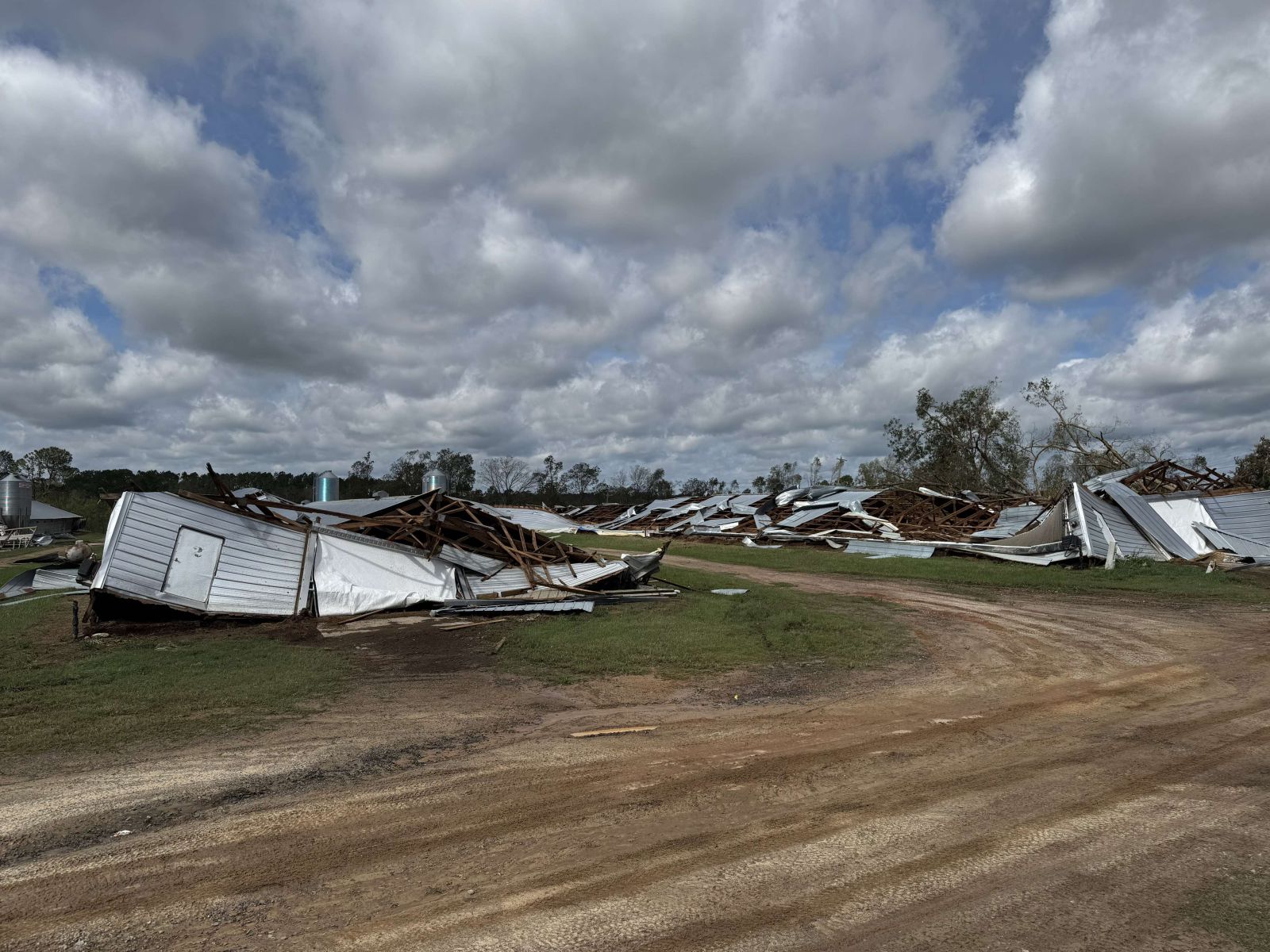
Poultry houses damaged by Hurricane Helene in Coffee County./Photo submittted by Angie O'Steen.
Farmers with any type of damage to their farms from Hurricane Helene are encouraged to take photos to document their losses to help state officials make requests for federal disaster funding and for filing USDA crop insurance or private insurance claims.
During a press conference this morning (Sept. 27) with Gov. Brian Kemp and the Georgia Emergency Management Agency (GEMA), Georgia Agriculture Commissioner Tyler Harper said the Georgia Department of Agriculture (GDA) is beginning to assess farm damage done by Hurricane Helene.
Harper stressed the importance of farmers documenting all damage they sustained with photos.
"My message to farmers is document, document, document," Harper said. "We need as much information as possible to ensure that we can get the needed resources and the needed help deployed as quickly as possible. We’ve already started discussions with Georgia’s U.S. Congressional delegation to get federal disaster declaration and funding.”
While ag damage is being reported statewide, Harper said some of the most significant impacts the GDA has heard about are east of I-75 from Valdosta to Augusta.
“We’re seeing and hearing about damage to pecan trees, poultry houses, flattened row crops, dairies and poultry houses without power along with food processing facilities without power,” Harper said.
According to the National Hurricane Center, hurricane-force winds extend outward up to 30 miles from the center of the storm and tropical-storm-force winds extend outward up to 310 miles, mainly to the east of the center. An automated station at Grassy Pond, Ga., just south of Valdosta, reported a wind gust of 96 mph just before 2 a.m., Sept. 27, the NHC reported. On Georgia’s Atlantic coast, Savannah International Airport reported a wind gust of 75 mph shortly before 2 a.m. on Sept. 27 as the storm was moving north through Georgia.
Georgia farmers continue to report ag damage they experienced in response to a question Georgia Farm Bureau staff posted this morning (Sept. 27) asking for locations and descriptions of ag damage from Hurricane Helene. To report your ag damage or view what has been reported, visit www.facebook.com/groups/FriendsOfGeorgiaFarmBureau/ .
GFB staff say farmers should feel free to report damage in the comments section of the post in the weeks ahead as some people may not have cell service and/or power for a couple of weeks.
"Our thoughts and prayers go out to all Georgians facing the devastation of Hurricane Helene. While we are still assessing the extent of its impact, this storm has already disrupted lives and caused significant damage, particularly within our farming communities,” Georgia Farm Bureau President Tom McCall said. “Georgia's producers are resilient. They’ve weathered storms before, and they will do it again. Georgia Farm Bureau stands ready to support our farmers as they work to recover and continue providing the food, fiber, and resources that sustain us all. In times like these, our strength comes from standing together and moving forward."
Farmers and rural residents who may find themselves needing to talk to someone have options. The Disaster Distress Helpline (1-800-985-5990) is available to anyone 24/7, 365 days a year.This national hotline provides immediate, confidential crisis counseling for anyone experiencing emotional distress related to any disaster. It’s toll-free, multilingual and staffed by trained crisis counselors ready to support you.
Georgia’s Department of Behavioral Health & Developmental Disabilities reports that confidential help is also available 24/7 by calling or texting 988.
South Georgia poultry farms hit hard
Numerous reports of flattened or damaged chicken houses came in from Appling, Atkinson, Bulloch, Coffee, and Jeff Davis counties. Reports like this are expected from more counties in Southeast Georgia.
On the Appling County poultry farm of Adam & Lori Carter, that they farm along with his father, Ludy Carter, Helene completely flattened two layer chicken houses and heavily damaged a third.
Thankfully the Carters were unharmed, and they didn’t have birds in the houses when the storm struck. As fate would have it, a new flock of hens was scheduled to have been placed in their houses the night of Sept. 26 but was canceled due to the pending storm.
“We are thankful we didn’t have birds when the storm struck. While we do have our chicken houses insured, they were older houses. We’ve been told we’ll receive about $100,000 per house but the cost to build a new chicken house is about $500,000,” Lori said.
This means the Carters must decide whether to take out a loan to cover the difference of what it will cost to build two new houses and possibly a third if it’s not deemed to be repairable by their poultry integrator. In the meantime, without these houses, they’ve lost their farm’s major income source.
The storm also damaged a stack house where chicken litter is stored before being applied to fields for fertilizer. Helene also damaged several farm shelters on the Carter’s family farm and damaged Adam and Lori’s home.
Although they don’t raise poultry themselves, Coffee County farmers Danny & Angie O’Steen have numerous neighbors who do.
“We are surrounded by poultry houses,” Angie said. “Pilgrim’s Pride is the largest employer in our area. There’s just lots of chicken houses, cotton and timber in our area.”
The O’Steens, who are active in Coffee County affairs and know their farming community well, estimate that half of the poultry houses in the county are either flattened or have some damage.
The Georgia Department of Agriculture (GDA) reports that 100 poultry farms in Coffee County were affected by the storm. A table egg producer in Pierce County has 17 houses down, according to the GDA. In Evans County five breeder houses are down and 12 pullet houses lost their roofs.
Pecan crop takes punch
Early reports of downed pecan trees came in to GFB via Facebook from Brooks, Bulloch, Burke, Candler Coffee, Jefferson, Richmond, Toombs counties. Most of Georgia’s pecan crop was weeks away from being harvested nuts were scattered to the ground that uprooted trees and limbs will make it hard to get to. These are just initial reports. Wide-spread damage across the state is expected.
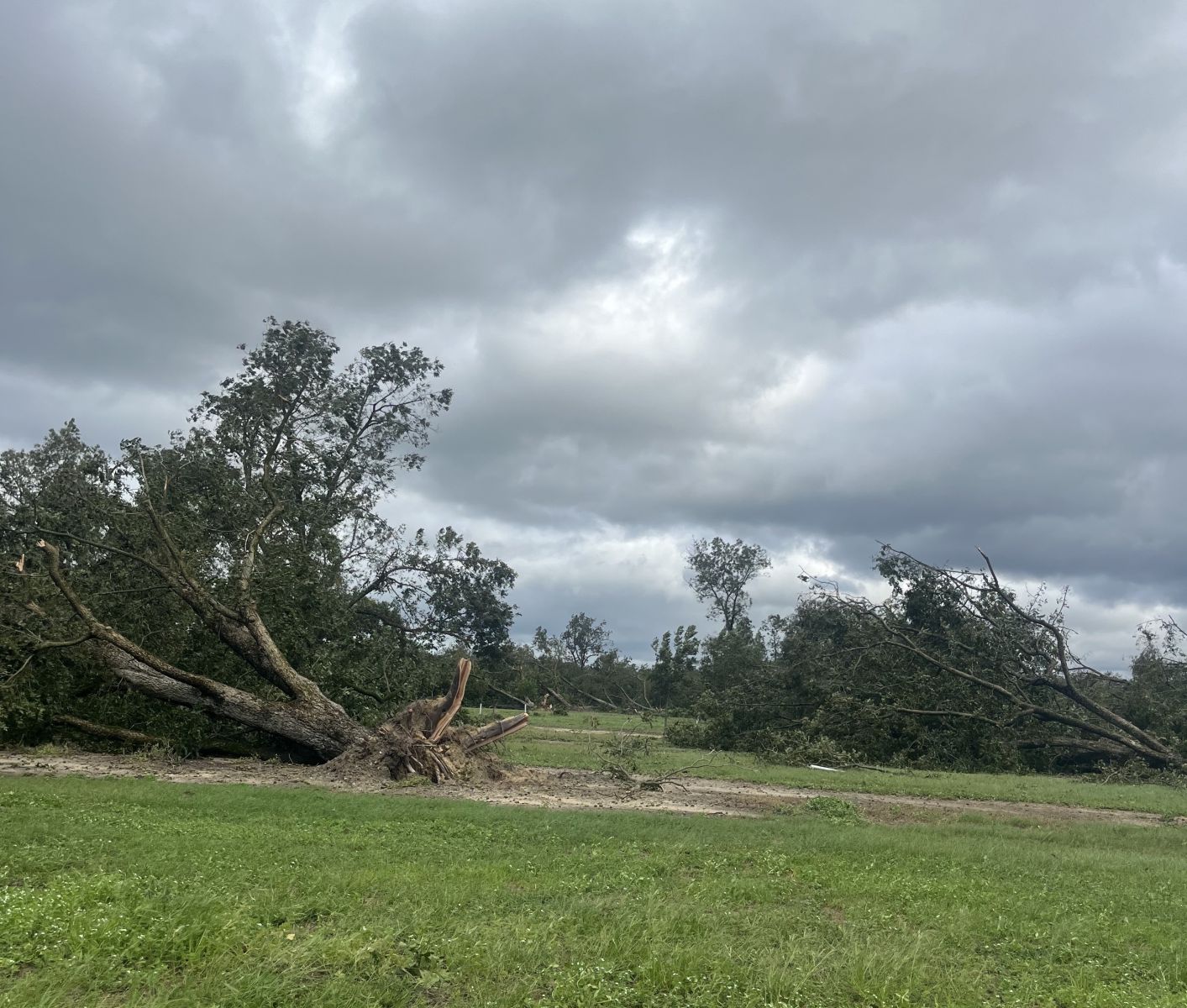
Look past the two trees in the foreground of this photo to see uprooted trees in the background in the orchards at Gary Bell's farm in Evans County - another county hit hard by Helene./Photo by Gary Bell
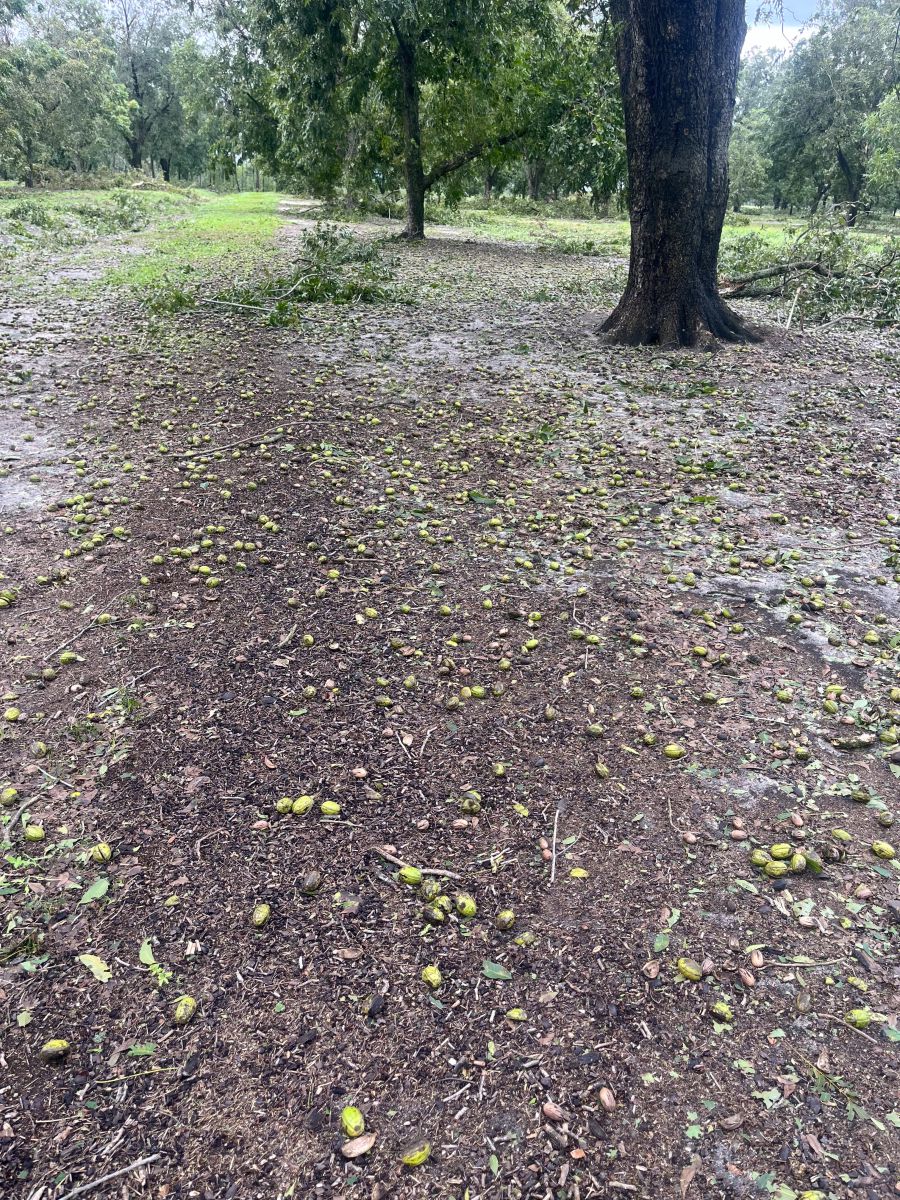
Helene blew many pecans still in their green husks off trees before they were ready for harvest. Many harvestable nuts - brown nuts out of the husks - ended up under uprooted trees and broken limbs./ Photo by Gary Bell
Cotton & timber losses
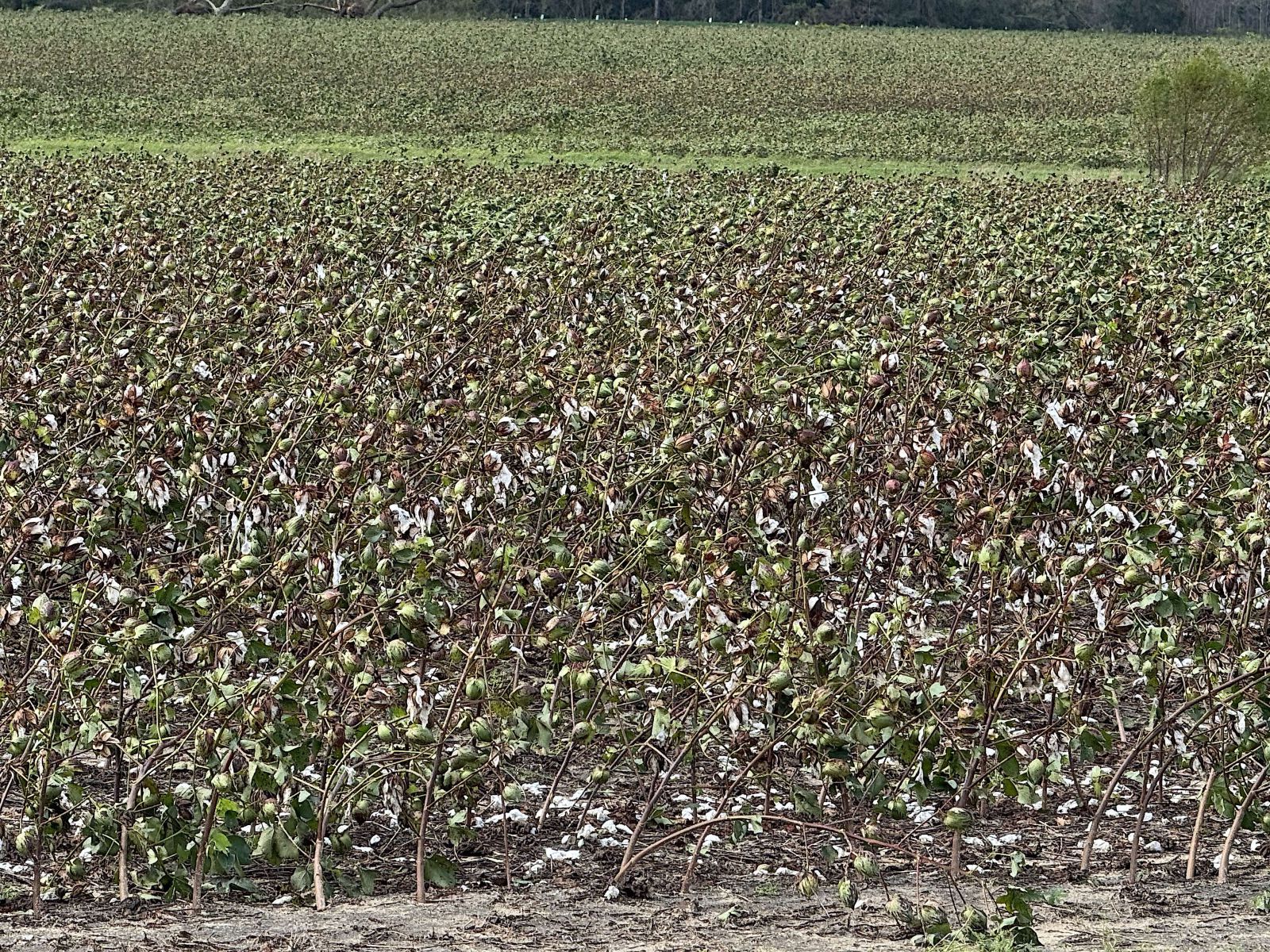
Helene left cotton on the O'Steen Farm in Coffee County blown out into the field, tangle and blown over./ Photo by Angie O'Steen
According to the Georgia Cotton Commission, affected cotton producers are reporting they have experienced yield losses ranging from 35% to a total crop loss.
Growers in Burke, Candler, Coffee and Turner counties reported damage to their cotton crops, and cotton damage is expected in more counties as restoration of power and communications services allows more reporting.
Danny O’Steen said his mature cotton that was days away from being defoliated - sprayed to make the leaves fall off so that the cotton bolls can be easily picked – is completely gone, blown out into the fields.
“Cotton in our county looks bad all the way around. The early maturing cotton is totally gone. The stems of the later maturing cotton is so flattened and tangled that it’s going to be hard to harvest, if it finishes maturing,” Danny said.
The O’Steens had an important family commitment in North Georgia this weekend that they couldn’t miss. As they traveled out of the county, they said they saw downed oak or pine trees on every road.
“It’s harvest time. Farmers are going to have to clear the roads just to get their peanut and cotton pickers to the fields in order to harvest their crops,” Angie said.
They witnessed acres and acres of timber that was snapped in half or “ leaning like a banana.”
On their farm, the O’Steens, based on what they could see from their vehicle, estimate that 45-70% of their 34-year old timber is damaged in some way.
“I’d say 15-20% is laid flat and another 30-50% is bent or leaning like a banana,” Danny said.
The couple drove from Ambrose to Dublin, about 50 miles, before they could get cell service.
Official crop losses for cotton and other crops, like peanuts and fall vegetables, will be determined in the coming weeks as University of Georgia Extension Service personnel collect data and the GDA completes its assessment.
"The kind of loss we saw all over Coffee County is incalculable and catastrophic," Angie said.
When asked how they managed to stay calm, Angie replied, "It's not always easy but we truly depend on the Lord and trust in Him. I don't know how people who aren't believers make it."
Peanuts picked before storm but plenty left to be harvested
In the days prior to Hurricane Helene coming ashore Thursday night, Facebook was flooded with photos of South Georgia peanut farmers working through the night, multiple nights to pick(up) peanuts they had dug out of the ground.
Scotty Raines in Turner County was one of these farmers. He harvested 200 acres of peanuts all week before Thursday night but had to leave 100 acres of dug peanuts exposed on the ground that he couldn’t get harvested before Helene came in on Thursday. He still has 350 acres of peanuts in the ground left to be dug and picked.
Danny O’Steen wasn’t able to harvest any of his peanuts before the storm because his crop was planted later due to excess rainfall during the planting season. He’s hopeful the peanuts will be ok but won’t know for certain until they’re harvested.
“It’s a wait and see game to see how peanuts are affected,” Danny said. “Some peanuts are ready to be harvested. Some are a month away. Sometimes after a tropical storm comes in peanut vines deteriorate . I’m not sure if the storms bring in salt, disease or if it’s just the excess moisture, but the crop often seems to be affected [if it’s still growing].”
Berrien County Farm Bureau member Jaclyn Ford sent in a photo of major damage to a peanut elevator and storage bin at her family’s peanut buying point at Dixon Farm Supply. Damage to peanut processing facilities will hinder getting the crop to their end users - food companies.
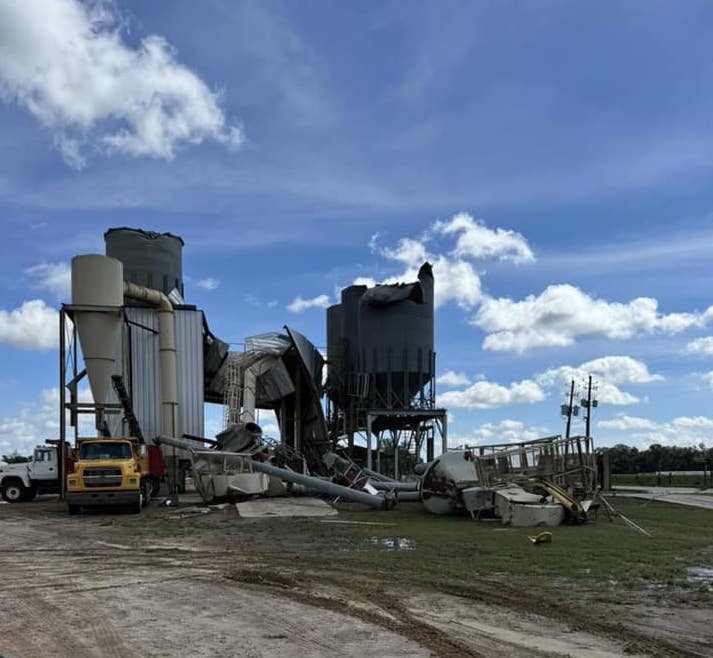
Damaged elevator at Dixon Farm Supply's Peanut Buying Point in Berrien County./Photo by Jaclyn Ford.
Agritourism & produce farms hit, too
In North Georgia, at Phillip and Ali Merk’s Jackson County agritourism farm, Helene blew over large portions of their maze of sun hemp. The storm also flooded fields that were prepped with raised beds covered in plastic for strawberry plants to be planted in two weeks.
“It could have been worse. Strawberries could have been planted. We still hope to plant in two weeks,” Phillip said via text.
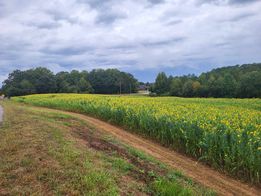
The sun hemp maze at Merk Farms in Jackson County before Helene came through North Ga. /Photo courtesy of Phillip Merk
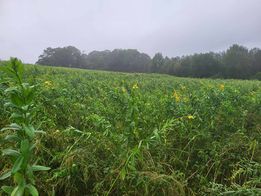
The sun hemp maze at Merk Farms in Jackson County after Helene struck. //Photo courtesy of Philip Merk
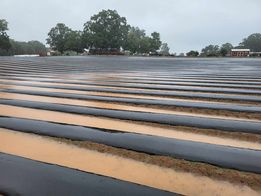
Merk Farm's flooded strawberry field. Hopefully the water will dry up in time for the Merk's to plant next spring's crop in two weeks./ Photo courtesy of Merk Farms
A major vegetable operation in Echols County that asked to remain unnamed reported harvestable produce destroyed along with multiple farm shops. The farm’s fall crops include squash, peppers and eggplants.
Danny O’Steen summed up Helene this way: “This was a storm of a lifetime that couldn’t have come at a worse time for Georgia farmers as they were starting the harvest season.”
GFB Women’s Leadership Committee member Lindsey Morgan described damage in Ware County this way, “Simply put, like a bomb went off.”
The eye of Hurricane Helene was shown by weather apps as having passed over Berrien County. “It’s a war zone in Berrien County,” Laney Staines said.
Fifteen dairy farms across Georgia were left without power thanks to Helene, a situation report issued by the GDA late on Sept. 27 said. These are located in Burke, Brooks, Morgan, Olgethorpe, Thomas and Wilkes counties. Seven of the 15 are able to operate using generators.
Resources in the aftermath
Visit https://agr.georgia.gov/hurricane-response-helene for tips and information from the Georgia Department of Agriculture regarding steps to take to protect your farms, homes and family after the storm. Visit https://gema.georgia.gov for information from the Georgia Emergency Management Agency. Visit https://www.cdc.gov/hurricanes/safety/how-to-safely-stay-safe-after-a-hurricane-or-other- tropical-storm.html for safety tips regarding flood water and food safety.
Farmers who suffer losses from Hurricane Helene & whose crops are covered for the crop year by the Federal Crop Insurance Program or the Noninsured Crop Disaster Assistance Program (NAP) are reminded to report crop damage to their crop insurance agent or local FSA office within 72 hours of discovering the damage and follow up in writing within 15 days.
Producers must keep accurate records to document damage or loss and to report losses to their local USDA Service Center as soon as possible. TAKE PHOTOS OF YOUR DAMAGE!!! Due to federal law, producers should not perform any cleanup efforts until your local FSA/USDA service center has completed an evaluation UNLESS there is an immediate threat to human life. Failure to comply could jeopardize a producer's payment eligibility.
Disaster programs for producers offered by USDA’s Farm Service Agency (FSA) include:
The Tree Assistance Program provides cost-share assistance to rehabilitate or replant orchards and vineyards when storms kill or damage trees, vines, or bushes. NAP or Federal Crop Insurance often only covers the crop, not the plant.
The Emergency Conservation Program and Emergency Forest Restoration Program can assist landowners and forest stewards with financial and technical assistance to restore damaged farmland or forests.
Visit https://gfb.ag/usdadisasterprogramsinfo for more info on these USDA disaster programs.
HURRICANE HELENE'S BIG PICTURE IMPACT
GEMA reports that Hurricane Helene, which entered Georgia about 1 a.m. last night as a Category 2 hurricane in the Valdosta area, has moved out of the state leaving behind wide-spread devastation in her wake.
During a press conference this morning, Gov. Brian Kemp said Southeast Georgia, particularly a path from Valdosta to Augusta is expected to have been the hardest-hit part of the state. Kemp said resources and manpower are being relocated from northwest Georgia to this area, but first responders and electric utility workers are active statewide.
Kemp said winds were clocked in Valdosta at 90 mph and winds in Alma in Bacon County were reported as high as 100 mph.
“This was a massive storm. It’s one of the widest statewide events we’ve experienced. Monetary wise this is going to be as big or bigger than Hurricane Michael in 2018,” Kemp said. “But we have a lot of hard-working, resilient people, and we’re going to be here to help Georgia.”
There are 15 known fatalities as of the early evening of Sept. 27 caused by the storm system that started affecting Georgia Sept. 26. There could be more as search and rescue responders work to cut through trees to get to 115 structures in Valdosta known to have people inside.
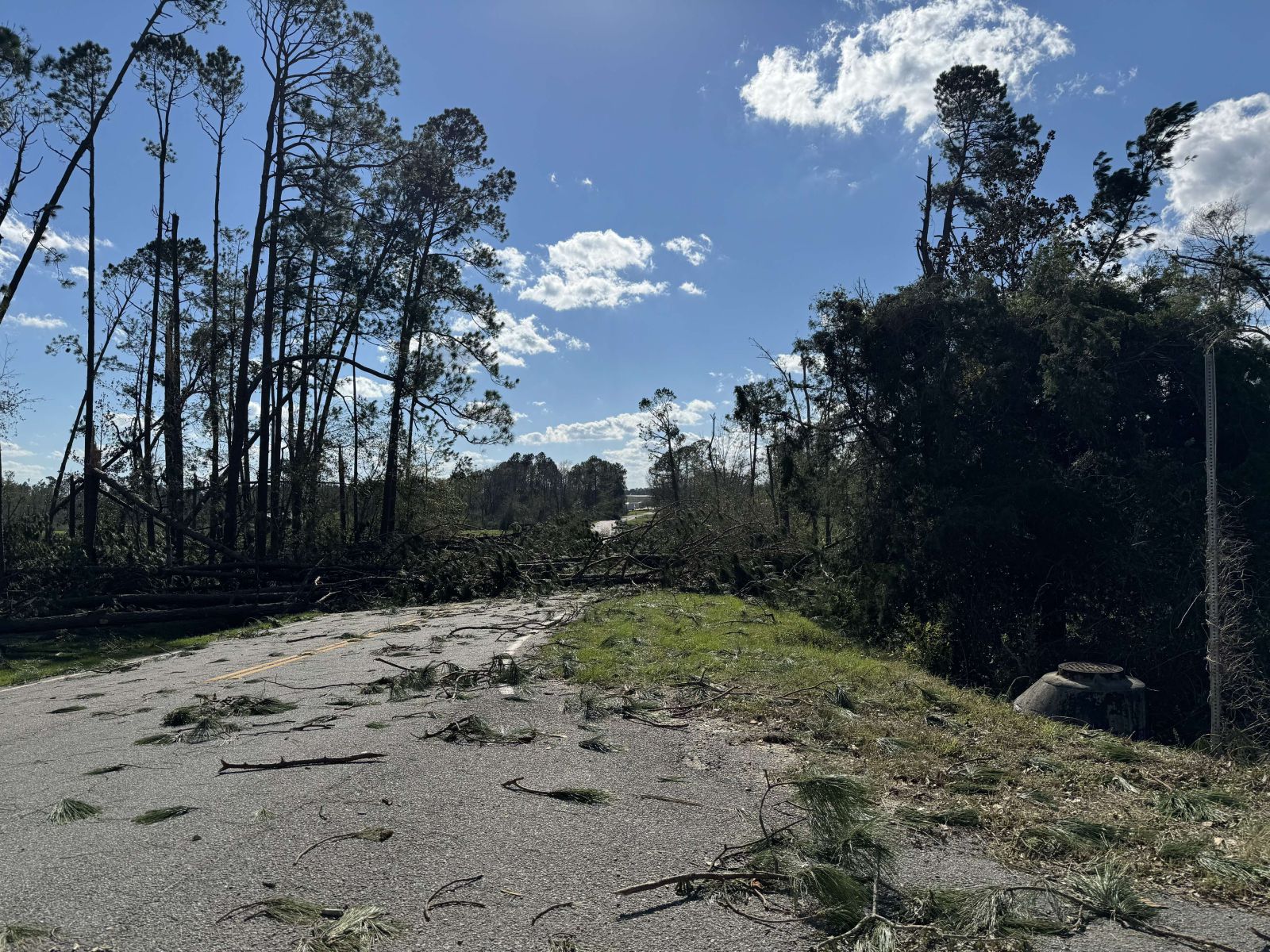
Kemp warned people in Southeast Georgia to refrain from getting out on the roads until emergency workers have had the chance to clear the roads of downed trees and power lines. More than 1.1 million power meter outages were reported across Georgia due to the storm.
“If you want to help and volunteer, please contact your local emergency management authorities,” Kemp said. “If you can stay at home, please hunker down for the next 24 hours. If you absolutely can’t, please be weather aware [that trees are still falling across roads due to saturated soils].”
Flooding, especially in northeast Georgia, is expected to continue or worsen over the next 12-36 hours, and trees are still falling due to saturated soils. A tree fell on the property of the Governor’s Mansion in Atlanta this morning, Kemp said.
Water is going to be released from Lake Rabun today as soon as neighborhoods south of the lake are evacuated. Homes in the area are not expected to flood from the water being released to relieve the lake of flooding from mountain streams that has poured into the lake but roadways in the area are expected to flood.
There is the potential for roads statewide to flood as water from North Georgia moves south in streams and rivers.
As of this morning of Sept. 27, GEMA was aware of 102 road closures statewide.
The Valdosta and Augusta Food Banks could not initially assess their facilities on Sept. 27 due to widespread tree damage and blocked roads, according to the Georgia Department of Agriculture. The Savannah Food Bank had large trees down around its facility but no warehouse damage.
INFO ABOUT POWER OUTAGES
Most of Georgia’s farmers & rural residents rely on Georgia EMC & their regional EMC’s for power. Georgia EMC is updating regional outage data every 15 minutes at https://georgiaemc.com/page/outages .
With outage numbers reaching more than double those caused by Hurricane Michael in 2018—the most significant damage to Georgia’s electric system in decades—EMCs warn there will be extensive delays in total restoration. With the severity of damage to the transmission and distribution systems, EMCs warn there will be extensive delays in total restoration. Consequently, some EMC members in the most damaged parts of the state—especially those who are medically fragile—are encouraged to make temporary arrangements.
The majority of the outages are currently in south, southeast, east and central Georgia. Outages in the northern half of the state increased the morning of Sept. 27 as the storm continued to barrel through Georgia.
To report an outage, contact your local EMC at https://georgiaemc.com/GeorgiasEMCs .
In addition to damage to the EMCs’ distribution lines, Hurricane Helene severely damaged high-voltage transmission lines. These transmission lines are a critical piece of the electric grid, as they feed the substations that provide power to EMC distribution lines. Georgia Transmission and local EMCs spent much of Friday, Sept. 27, conducting an extensive damage assessment of Georgia’s power grid. Many repair crews had to cut trees blocking their exit from staging areas.
Crews are discovering catastrophic damage to the electric infrastructure. Georgia Transmission estimates that more than 100 high-voltage transmission lines and 60+ associated electrical substations are currently out of service.
Thanks to mutual aid agreements with EMCs across the U.S., crews and equipment have already arrived and are continuing to arrive from Texas, Oklahoma, Illinois, Indiana, Kentucky, Tennessee, Virginia, Pennsylvania, Missouri, Arkansas, Iowa, Ohio and Alabama. Efforts to bring in additional crews are ongoing.
Georgia Power Company reported approximately 650,000 customers without power as of 7:30 a.m. Sept. 27. About 100,000 of those were restored within a few hours. According to a timeline on the Georgia Power website, the company got help from crews from 35 companies coming from 11 other states, with 10,000 workers on the ground working to reduce electrical hazards from downed power lines and restore power service. By 2 p.m., 500 damage assessment teams were deployed to direct restoration efforts. Georgia Power customers can report outages at https://customerservice2.southerncompany.com/.../Location....
- Categories:
- Tags: